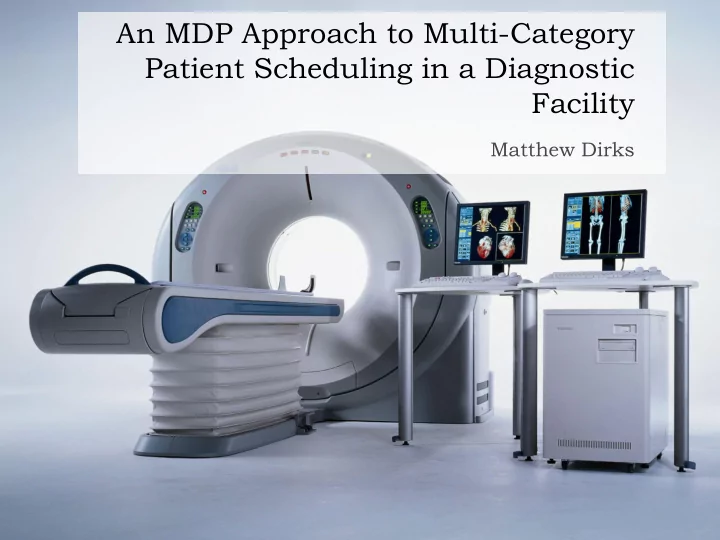

An MDP Approach to Multi-Category Patient Scheduling in a Diagnostic Facility Matthew Dirks
Overview Solution Question: Ethics Algorithm Results & Analysis Questions
Types of patients: Emergency Patients (EP) Critical (CEP) Non-critical (NCEP) Inpatients (IP) Outpatients Scheduled OP Add-on OP: Semi-urgent (OP) (Green = Types used in this model) What if more than 2 CEPs arrive?
Proposed Solution Finite-horizon MDP Non-stationary arrival probabilities for IPs and EPs Performance objective: Max $
Performance Metrics (over 1 work-day) Expected net CT revenue Average waiting-time Average # patients not scanned by day’s end
Some discussion… They assume waiting NCEPs, IPs, and OPs are identical in terms of clinical urgency. Focus on $ Good for the hospital What will people think? Can there be any ethical problems related to use of such a model in hospitals? Is revenue a good metric for performance? Especially if you consider that life and death might depend on the scheduling results
Algorithm State 𝑡 = (𝑓 𝐷𝐹𝑄 , 𝑥 𝑃𝑄 , 𝑥 𝐽𝑄 , 𝑥 𝑂𝐷𝐹𝑄 ) 𝑓 𝐷𝐹𝑄 CEP arrived 𝑥 𝑢𝑧𝑞𝑓 Number waiting to be scanned Action 𝑏 = (𝑏 𝑃𝑄 , 𝑏 𝐽𝑄 , 𝑏 𝑂𝐷𝐹𝑄 ) 𝑏 𝑢𝑧𝑞𝑓 Number chosen for next slot State Transition 𝑡 ′ = (𝑒 𝐷𝐹𝑄 , 𝑥 𝑃𝑄 + 𝑒 𝑃𝑄 - 𝑏 𝑃𝑄 , 𝑥 𝐽𝑄 + 𝑒 𝐽𝑄 - 𝑏 𝐽𝑄 , 𝑥 𝑂𝐷𝐹𝑄 + 𝑒 𝑂𝐷𝐹𝑄 - 𝑏 𝑂𝐷𝐹𝑄 ) d Whether a patient type has arrived since the last state
Maximize total expected revenue Terminal reward obtained 𝑊 𝑂+1 𝑡 = −𝑑 𝑃𝑄 𝑥 𝑃𝑄 − 𝑑 𝐽𝑄 𝑥 𝐽𝑄 −𝑑 𝑂𝐷𝐹𝑄 𝑥 𝑂𝐷𝐹𝑄 Optimal Policy Solving this gives the policy for each state, n, in the day
Simulation 100,000 independent day-long sample paths Result Metric Percentage Gap in avg. net revenue = 𝑏𝑤 𝑜𝑓𝑢 𝑠𝑓𝑤𝑓𝑜𝑣𝑓 𝑝𝑞𝑢𝑗𝑛𝑏𝑚 𝑞𝑝𝑚𝑗𝑑𝑧 − 𝑏𝑤 𝑜𝑓𝑢 𝑠𝑓𝑤𝑓𝑜𝑣𝑓(ℎ𝑓𝑣𝑠𝑗𝑡𝑢𝑗𝑑 𝑞𝑝𝑚𝑗𝑑𝑧) 𝑦 100 𝑏𝑤 𝑜𝑓𝑢 𝑠𝑓𝑤𝑓𝑜𝑣𝑓 𝑝𝑞𝑢𝑗𝑛𝑏𝑚 𝑞𝑝𝑚𝑗𝑑𝑧 Closer you are to 100%, the better. 100% means that Heuristic got $0 revenue 75% means Heuristic resulted in 4 times less than (25% of) what Optimal got.
Heuristics FCFS : First come first serve R-1 : One patient from randomly chosen type is scanned R-2 : One patient randomly chosen from all waiting patients (favors types with more people waiting) O-1 : Priority OP NCEP IP O-2 : Priority: OP IP NCEP
Single-scanner
Why do we need a sensitivity analysis? Two-scanner
Number of patients not scanned
Waiting-time
Questions Why do they try to make the problem so specific? This is a scheduling problem with some constraints and an objective function that occurs in many scenarios. Eg. Scheduling multi-category rooms (project-equipped, conference-capable, etc.) and scheduling these rooms given a series of streaming tasks or scheduling different kinds of cars for different requests. How about making a generic framework with some specific parameters that can cater to a variety of problems? Their focus is on revenue cost specifically of CT scans. They wanted to test how tweaking the parameters within this specific case could affect revenue. A more general method would not provide specific dollar values about increased/saved revenue.
Questions Is it appropriate to use the Markov assumption for this scheduling problem? Perhaps we can iteratively improve their schedule after every day, especially if there are some OPs who did not show?
Questions The authors acknowledge that simple heuristic policies perform nearly on-par with their relatively complex MDP- derived policies. In practice, how often do medical providers use “smart” policies like the MDP vs. the simpler heuristic policies?
Questions or Comments?
Recommend
More recommend